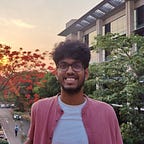My Preparations for Google Summer of Code 2021 @ Dask!
This isn’t your run-of-the-mill GSoC acceptance narrative. I’ll tell you, it was a combination of being at the right place at the right time, talking to the right people, and doing something… fun.
I was fortunate to be introduced to the Open Source World throughout my secondary school years! For my regular work, I had been using Open Source tools. It all started in 9th grade when I used aircrack-ng to pen-test my WiFi network, and it’s been a wild ride ever since.
I’ve always wanted to give back to the community and have been a huge admirer of contributing to Open Source groups. The concept of free shared software appeals to me. It’s so simple and yet so amazing!
‘Free software’ is a matter of liberty, not price. To understand the concept, you should think of ‘free’ as in ‘free speech,’ not as in ‘free beer’.
- Richard M. Stallman
So, how did my interest in Open Source turn into me working with a great organization Dask this summer? Enter Google Summer of Code! An initiative by Google that helps open source organizations connect with interested students and get them started with their Open Source projects. I was first introduced to GSoC around the start of my freshman year at IIIT Hyderabad (a college well known for the number of students selected to work for a GSoC organization every year). It sounded like a buzzword to me in the beginning — “Google” Summer of Code. However, the excitement surrounding Google’s engagement faded quickly as I learned more about the program from my experienced seniors who had been picked during past GSoC cycles. One thing became abundantly evident to me: this is a really simple and uncomplicated procedure. I make direct contributions to the Open Source community. Google is simply supporting this excellent endeavor by paying respectable stipends to summer interns.
The finest thing about GSoC isn’t the Google link, but rather the amazing chance afforded to college students to engage directly with organizations and learn how to produce consistent, clean code while also logically architecting the structure of a huge codebase.
That’s all! I concluded that GSoC was too amazing a chance to pass up. I began researching various organizations before landing on Dask. I was astounded when I read about their project ideas for this year! They were looking for someone that mirrored me! VISUALS!!!!!!! They wanted to improve the visualization of their task graphs and were looking for someone who was proficient in Python and JavaScript. To make sense of complex data, I enjoy employing simple and attractive visualizations. Dask seems to be the best option. That’s exactly what I’d be doing at Dask! I would improve the task graph display by adding color coding and creating collapsible chunks to intuitively illustrate complex computations and illustrate the opportunity for optimizations.
As a result, I began contributing to their repositories and actively participating in discussions about my project. I communicated with my mentors, asked them questions, attended summits, and spent hours poring over the dask/dask codebase! This was a new experience for me, and I was as excited as a young child riding a bike for the first time! Then what happened? I wrote a strong proposal for the project, and it got accepted! Freyam Mehta will be spending his summer working under fantastic supervision!
Visualizing the Performance Characteristics of Computations (Dask)
Of course, none of this would have been possible without the help of many people in my life. I am eternally grateful to them, and I am pleased that fate has blessed me in the long run. I am quite pleased about this opportunity since I believe it will allow me to explore new technology. I also get to learn crucial skills like research, training, design, outreach, quality assurance, coding, and, most importantly, I get to meet new people, connect with them, and share ideas!
“You can never cross the ocean until you have the courage to lose sight of the shore.”
My Google Summer of Code story is no different. I didn’t focus on the goal; rather I focused on the process.
P.S. There are various blogs and videos on how GSoC works. I’ve included links to a few of them below. Feel free to search the web for useful materials and tips. But be careful not to become engrossed with this. Don’t research GSoC for longer than two days. The majority of your preparation time should be spent with your dream organization, participating and talking, rather than watching GSoC YouTube tutorials. This is a trap that many students fall into. So, be cautious.
Kunal’s video series on GSoC at Code for Cause was really appealing to me. Kunal strikes me as a sincere individual who appreciates the true essence of Open Source.
I don’t think you need to watch anything else. Kunal does an excellent job at summarizing everything. You can believe what he’s saying.
Following the watching of these two movies, begin shortlisting organizations based on your interest in the project and the technology stack involved. That’s all there is to it. Join their respective channels, introduce yourself, and begin contributing!
Every student should at least try to contribute to Open Source, and Google Summer of Code is an excellent platform for this.
Adios 👋!
